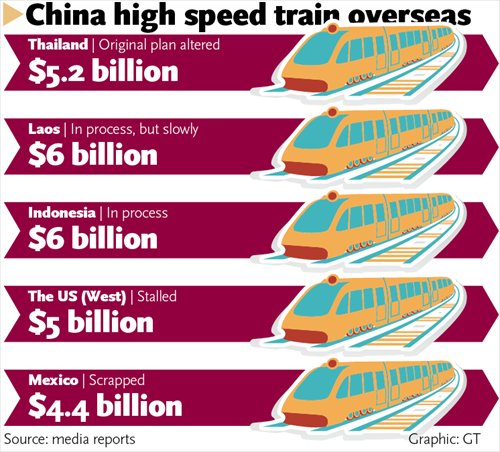
(Graphic/GT)
Economies of scale biggest consideration
Experts said on Sunday that a series of setbacks suffered by the country's high-speed rail exports underlines need for caution in striking deals, and urged a more prudent approach focused on revenue in the overseas marketing of the country's advanced and competitive technology.
On Thursday, XpressWest, a U.S. company which offered to build a 370-kilometer-long high-speed rail link between Las Vegas and Los Angeles, unilaterally terminated a joint venture formed in September 2015 with Chinese consortium China Railway International (CRI).
China Railway Corp, the country's railway operator and CRI's parent firm, called on Friday the U.S. firm "irresponsible," and said it has been legitimately negotiating this matter.
Several other overseas high-speed rail projects also face problems.
In March, Thailand said it would take full responsibility financing its high-speed rail project and greatly reduced the length of the proposed railway, though it would still purchase Chinese trains and Chinese technology, according to media reports.
In Laos, little progress has been made on a China-related high-speed railway project following a ground-breaking ceremony in December 2015.
And in Venezuela, a rail project that began in 2009 came to a complete stop after the country plunged into an economic crisis amid record low global crude prices.
China has built the world's largest high-speed rail network in less than a decade.
As of the end of 2015, China operated 19,000 kilometers of high-speed railway, and another 10,000 kilometers are under construction, according to China Railway Corp (CRC)'s official website.
However, only one line between Beijing and Shanghai is profitable, and CRC is officially saddled by a debt of more than 4 trillion yuan ($610 billion).
Railways hasten local economic development. Qufu, a county-level city, attracted a Shangri-la hotel partly because it sits along the Beijing-Shanghai high-speed railway line, reports said.
Yet infrastructure investment should only moderately outpace the area's potential but never outpace it too much, Sun Zhang, a rail expert and professor at Shanghai Tongji University, told the Global Times Sunday.
Globally, more homework needs to be done to understand the political, legal, environmental and labor aspects of the country that imports China's rail technology, Sun noted, adding that an accurate reading of the demand of a high-speed railway that see trains running at speeds of 250 to 350 kilometers per hour is essential because of the costs involved.
There is no denying that China's high-speed rail technology is arguably the best in the world, but is only good as long as the buyer can afford it, Zhao Jian, a professor at Beijing Jiaotong University, told the Global Times Sunday.
"An Audi A4 is considered a good car. But can you imagine everyone owning one? That's simply unrealistic," Zhao noted, adding that perhaps it is better that such a project in the U.S. was scrapped.
"The Beijing-Shanghai high-speed railway turned profitable because of a passenger flow reaching 100 million per year. What's the population in Los Angeles? 13 million," Zhao said.
Zhao said high-speed rail investment is motivated by profit, and should not be confused with aid projects China used to have when it helped build railways in less developed countries, like projects in Africa.
The U.S. case is unique because it's the first time a company in a developed country dishonored a business deal, Sun said, noting that there is a possibility that politics scuttled the deal.
Sun said China's rail products are suitable under any climate condition, and boast of advanced cargo train technology, provided careful study is carried out to understand the foreign country's needs.
"Will they need railways to transport passengers or cargo, or both? This needs to be determined beforehand," Sun said.
"With the population base used as a measure of potential traffic flow, the same profitability issues will perhaps haunt other projects in Southeast Asia. India has a large enough population to make high-speed rain profitable. The question is can India afford the construction of such a project," Zhao said.


















































